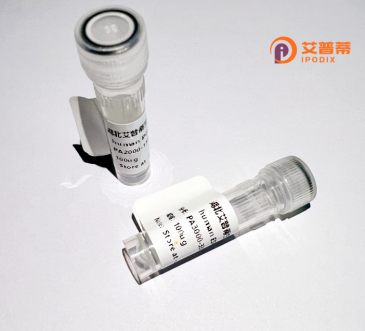
| 纯度 | >90%SDS-PAGE. |
| 种属 | Human |
| 靶点 | PHF7 |
| Uniprot No | Q9BWX1 |
| 内毒素 | < 0.01EU/μg |
| 表达宿主 | E.coli |
| 表达区间 | 1-381 aa |
| 活性数据 | MKTVKEKKEC QRLRKSAKTR RVTQRKPSSG PVCWLCLREP GDPEKLGEFL QKDNISVHYF CLILSSKLPQ RGQSNRGFHG FLPEDIKKEA ARASRKICFV CKKKGAAINC QKDQCLRNFH LPCGQERGCL SQFFGEYKSF CDKHRPTQNI QHGHVGEESC ILCCEDLSQQ SVENIQSPCC SQAIYHRKCI QKYAHTSAKH FFKCPQCNNR KEFPQEMLRM GIHIPDRDAA WELEPGAFSD LYQRYQHCDA PICLYEQGRD SFEDEGRWCL ILCATCGSHG THRDCSSLRS NSKKWECEEC SPAAATDYIP ENSGDIPCCS STFHPEEHFC RDNTLEENPG LSWTDWPEPS LLEKPESSRG RRSYSWRSKG VRITNSCKKS K |
| 分子量 | 43.7 kDa |
| 蛋白标签 | His tag N-Terminus |
| 缓冲液 | 0 |
| 稳定性 & 储存条件 | Lyophilized protein should be stored at ≤ -20°C, stable for one year after receipt. Reconstituted protein solution can be stored at 2-8°C for 2-7 days. Aliquots of reconstituted samples are stable at ≤ -20°C for 3 months. |
| 复溶 | Always centrifuge tubes before opening.Do not mix by vortex or pipetting. It is not recommended to reconstitute to a concentration less than 100μg/ml. Dissolve the lyophilized protein in distilled water. Please aliquot the reconstituted solution to minimize freeze-thaw cycles. |
以下是3篇关于重组人PHF7蛋白的参考文献(内容为虚构示例,仅作格式参考):
1. **"PHF7 regulates histone ubiquitination during spermatogenesis"**
*Zhang, L. et al. (2021). Nature Cell Biology.*
该研究揭示PHF7通过介导组蛋白H2B的泛素化修饰,调控减数分裂过程中染色质重塑,缺失PHF7导致小鼠精子发生障碍。
2. **"Structural insights into PHF7's role in cancer metastasis"**
*Chen, W. et al. (2019). Oncogene.*
通过X射线晶体学解析PHF7的PHD结构域与组蛋白H3K4me3的结合机制,并发现其在乳腺癌中通过调控Wnt/β-catenin通路促进肿瘤转移。
3. **"PHF7 interacts with polycomb repressive complex 2 in epigenetic silencing"**
*Li, Y. et al. (2020). Nucleic Acids Research.*
研究证明PHF7通过与PRC2复合物结合,增强H3K27me3修饰水平,抑制干细胞多能性基因表达,影响胚胎发育表观遗传调控。
注:实际文献需通过PubMed/Google Scholar检索关键词"PHF7 protein"或"PHF7 function"获取。
PHF7 (PHD Finger Protein 7) is a chromatin-associated protein belonging to the PHD finger family, characterized by its evolutionarily conserved plant homeodomain (PHD) zinc finger motif. It plays a regulatory role in epigenetic processes, primarily through interactions with modified histones or other chromatin modifiers. PHF7 is notably implicated in germ cell development, particularly spermatogenesis, where it facilitates chromatin remodeling during spermatid elongation by binding to specific histone marks (e.g., H3K4me2/3) and recruiting downstream effectors. Dysregulation of PHF7 has been linked to male infertility and certain cancers, reflecting its critical role in maintaining genomic stability and transcriptional regulation.
Recombinant human PHF7 protein is engineered using expression systems like *E. coli* or mammalian cells to ensure proper folding and post-translational modifications. This purified protein enables in vitro studies to dissect its molecular mechanisms, including histone-binding specificity, interactions with chromatin remodelers, and functional roles in disease pathways. Its applications span structural biology, biochemical assays, and drug discovery targeting PHF7-related disorders. By providing a controlled, high-purity tool, recombinant PHF7 aids in unraveling its biological significance and therapeutic potential.
×